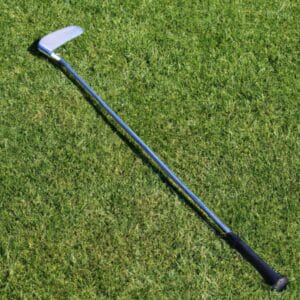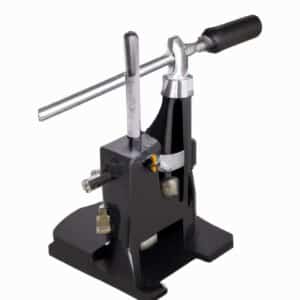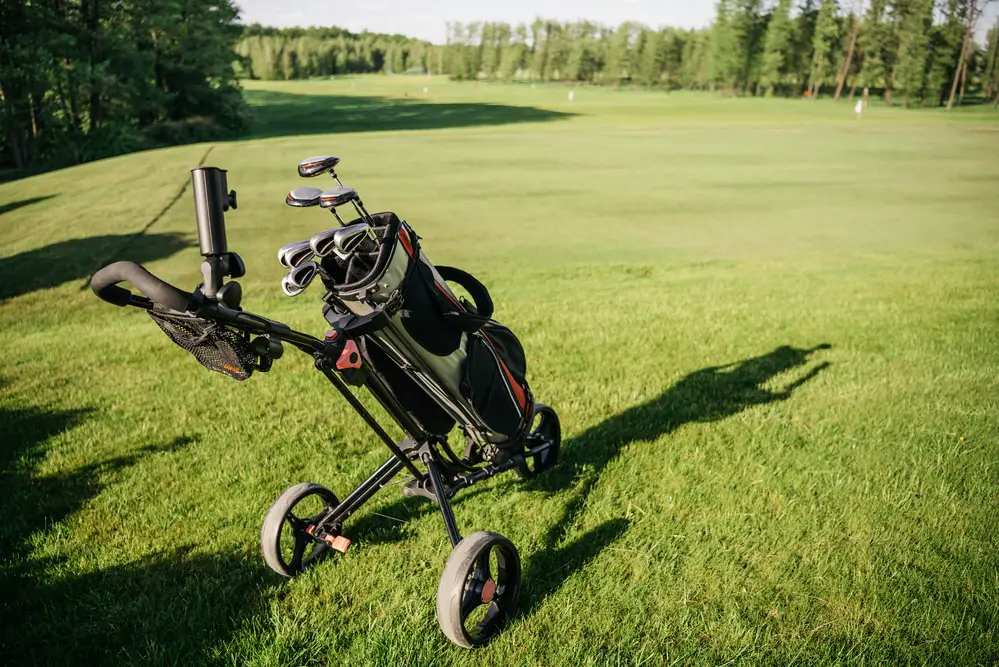Last Updated on June 7, 2023
Are you an aspiring golfer looking to take your game to the next level? If so, bending golf clubs’ lie angle is a great way to customise your clubs and get exactly what you need from them. Bending golf clubs might seem like something that should only be done by professionals, but it can actually be done safely at home with just a few simple tools! In this article, we’ll walk through how to bend golf clubs’ lie angle in three easy steps – quickly and easily. So if you’re ready to start customising your own equipment, read on!
The first step of bending a golf club lie angle is getting all the necessary materials together. You’ll need some clamps, sandpaper, protective eyewear and gloves, a mallet or hammer, and of course, the correct tool for the job. Depending on whether you plan to adjust steel or graphite shafts will determine which type of tool you need. Once all these items are gathered, it’s time to move on to the actual process of changing the lie angle.
Finally, once everything is set up correctly and safely secured via the clamping system, it’s time to begin adjusting the lie angle. This part requires patience as well as precision; use slow, steady strikes with either the mallet or hammer against the adjustment tool until you reach the desired result. Make sure not to overdo it – too much force can damage both your equipment and yourself! After each strike, check for accuracy before continuing forward. With these tips in mind, you’ll soon have perfect customised clubs tailored specifically to your needs!
Understanding Lie Angles for Different Golf Clubs
It’s important to understand the lie angle of your golf clubs in order to get the best performance out of them. Lie angles are the angle between the sole and shaft, usually measured from the ground up when a club is at address. They differ by type of club, as well as length and weight. Longer clubs tend to have flatter lie angles than shorter ones since they require more loft for proper impact with the ball. Shaft flexibility also affects lie angles; stiffer flexes produce lower lies, while softer flexes create higher lies.
To ensure that you get optimal results from your clubs, it’s best to adjust their lie angles specifically for you. This can be done easily at home if you know how to do it correctly and safely.
Necessary Tools and Supplies
Once you understand the lie angle of different golf clubs, it’s time to gather all the necessary tools and supplies for bending them. You’ll need a specialised bending tool that is designed to fit over the club shaft and has adjustable settings to allow you to make proper adjustments. A clamping device is also needed in order to keep the club steady while making adjustments. Additionally, a heat source such as a hair dryer or heat gun can be used if desired. Finally, you’ll want to have a lie angle gauge available so that you can measure your changes accurately. With these items on hand, you’re ready to start adjusting your clubs’ lie angles at home!
Pre-Bending Tips and Tricks

Bending golf clubs lie angle at home can be a tricky task. To ensure that you get the job done correctly, there are some pre-bending tips and tricks to keep in mind.
Firstly, it is essential to understand your desired lie angle before attempting any adjustments. This will help you better determine how much of an adjustment needs to be made so that it fits your particular swing dynamics. Secondly, use the right tools for the job. It’s important to have quality equipment such as a bending machine or pliers specifically designed for bending golf club lies angles when making adjustments. Thirdly, make sure to practice different techniques on scrap pieces of metal prior to making final changes on expensive clubs. Lastly, research various setup options available online from trusted sources like professional tour players or PGA teaching professionals who specialise in customising golf club setups.
By following these pre-bending tips and tricks, you can confidently adjust your own golf clubs’ lie angle at home with confidence. With just a little bit of care and skilful technique, you can customise your clubs for optimal performance during each round of golf!
Step-By-Step Instructions
Changing the lie angle of your golf clubs at home is a simple process if you take the right steps and practice proper safety precautions. This step-by-step guide will help you understand what equipment you need, how to measure the existing lie angle of your club, make an adjustment, and complete the job safely.
First, it’s important to have all the supplies needed for this project before beginning. You will need bending bars or jigs that are specifically designed for golf club adjustments as well as some basic tools such as wrenches, measuring tape, and screwdrivers. Additionally, protective eyewear should be worn during any alteration to ensure safety.
To begin changing the lie angle of a golf club, measure its current lie angle with a protractor tool from a local hardware store or online retailer. Once you know where to place your bending bar or jig on the shaft in order to achieve desired results, use one hand to secure it while using the other hand to adjust accordingly with gentle pressure until reaching desired specifications according to manufacturers’ recommendations. Finally, double-check measurements again after completing club adjustment by remeasuring with the protractor tool once more – taking care, not to over bend – and enjoy newly adjusted clubs!
Checking the Resulting Lie Angle
Verifying the lie angle of a golf club after bending is important to ensure accuracy. To measure it, one should use an accurate protractor or lie board and check the angles against a pre-bent club for comparison.
First, place the bent golf club on top of the protractor with the sole flat across its surface. Then, rotate the head until you find where the centre line aligns with zero degrees. Mark this point on your protractor and make sure that it corresponds to what was marked as zero before bending began. Finally, compare this resulting measurement with your desired lie angle. If they match up correctly, then you’ve successfully adjusted your clubs’ lie angle!
Adjustments to Make If Needed

If you find that your club’s lie angle is not at the correct angle, adjustments can be made. To make a bending adjustment to change the lie angle of the golf club, there are two main tools needed: a Lie Angle Bender and a Lie Angle Gauge. With these tools, it will be easy to identify where and how much needs to be adjusted in order to get the desired lie-angle change.
The process of adjusting the lie angle involves measuring the current angle alignment with a Lie Angle Gauge and making small adjustments using a Lie Angle Bender until the correct angle is reached. This ensures that all clubs in your set have an identical lie-angle-adjustment so they perform as expected during each shot. It also helps to minimise any inconsistency or misalignment when playing on different courses or conditions. Once complete, check again with the gauge to ensure accuracy before use.
By following this simple process, you can easily adjust your golf clubs’ angles at home for optimal performance without needing professional help.
Safety Considerations
It’s important to consider safety when bending lie angles on golf clubs at home. Taking the proper protective measures is essential for successful and safe club bending. To begin, make sure you have a vice securely clamped onto a sturdy workbench so that it doesn’t move around while adjusting the lie angle of your golf club. Additionally, wear thick gloves to protect your hands from any sharp edges or slipping tools. It’s also wise to invest in some heavy-duty pliers as they are designed specifically for manipulating metal without damaging them. Lastly, never use power tools such as an electric grinder or drill with metal grinding bits; these can easily cause too much heat, which could weaken the shafts and severely damage your golf club. Therefore, only use hand tools for this job and take all necessary precautions for a safer process when bending lie angles at home.
Maintaining the Club’s Lie Angle Over Time
Maintaining the lie angle of a golf club is essential for optimal play, and thankfully it can be done at home. The best way to maintain your clubs’ angles over time is through periodic checking and adjustments. To do this, you’ll need some basic tools, such as an adjustable club bending machine or a simple lie board.
| Tool | Use |
|---|---|
| Adjustable Club Bending Machine | Used to adjust the loft and lie angle of individual clubs by applying pressure on specific points along the shaft. |
| Lie Board | A thin metal board with lines that indicate different degrees of loft and lie angles. It’s used in conjunction with a clamping device to measure the angles accurately. Also known as “lie sticks”. |
The first step when adjusting your clubs’ lies should always involve measuring them against one another so that you know what needs work. This can easily be done using either tool mentioned above; simply place each head next to its corresponding face-on line on the board or into the clamps attached to the machine’s baseplate. Once everything looks straight, move on to making any necessary adjustments, taking care not to bend too much in one go – small increments are key!
To ensure long-term maintenance of your clubs’ angles, take note of their measurements after every round and make sure they’re still consistent before playing again. If discrepancies arise between rounds, use your preferred method (club bending machine/lie board) to check their respective lofts & lies again and fix accordingly – little changes can make big differences in performance!
Alternatives to Bending at Home

If you don’t feel comfortable bending your golf clubs at home, there are other viable options. Professional golf-fitting services have the expertise and tools to adjust lie angles for a perfect fit. With these services, highly trained technicians use specialised equipment such as precision measuring devices and high-quality golf club bending tools to make sure that the lie angle is adjusted precisely. This type of professional golf club bending can be done on-site or in an indoor facility with state-of-the-art technology.
Another option is visiting a local pro shop where that offers custom golf club bending and lie angle adjustment services. Highly qualified professionals will measure your swing and then adjust the lie angle accordingly. They also provide expert advice on choosing new clubs that best suit your needs and abilities. So if you’re looking for a more accurate way to get fitted for optimal performance, this could be the right choice for you.
Frequently Asked Questions
How Much Does It Cost to Bend a Golf Club’s Lie Angle at Home?
The first thing to consider when looking at the cost of bending a golf club lie angle at home is the type of equipment needed. You’ll need some specialised tools, such as a vice with adjustable jaws, sandpaper or files, and measuring gauges. All these items can be purchased separately, or you may choose to invest in a kit that contains all the necessary pieces. The price for such kits ranges from around $50-$150, depending on brand and quality. In addition to purchasing the materials listed above, there are also services available where experts will do the job for you; however, they can be expensive as prices start around $200 per session.
It’s worth noting that while learning how to properly adjust your clubs’ lie angles yourself has its advantages – like saving money – it should not be attempted by those who have no experience working with metal components. If done incorrectly, it could lead to further damage, which would add more costs down the road. It’s highly recommended that beginners consult professional help instead of taking matters into their own hands without proper instruction or knowledge.
Conclusion
In conclusion, it is possible to bend a golf club lie angle at home. It doesn’t take long and won’t cost you much either. The risks involved are minimal, but there’s always the chance of damaging your clubs in some way if you don’t do it correctly. Once bent, make sure to maintain your new lie angle by frequently checking its accuracy using a simple protractor tool. If this whole process seems too daunting for you, then consider having a professional do the job instead – they have all the right tools and expertise needed to get the job done quickly and accurately. All in all, bending golf club lie angles can be an economical way to customise your setup so that it best suits your game – just make sure you know what you’re doing!



